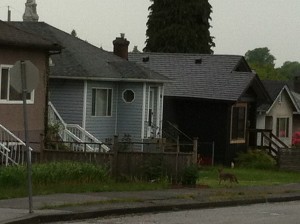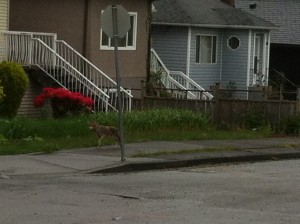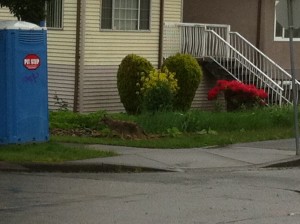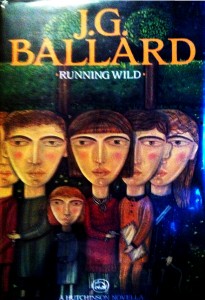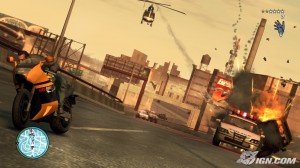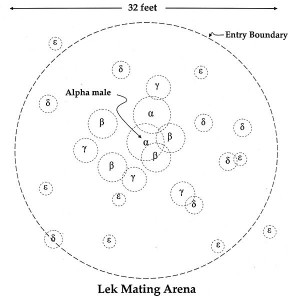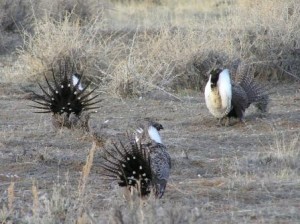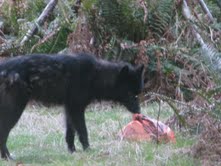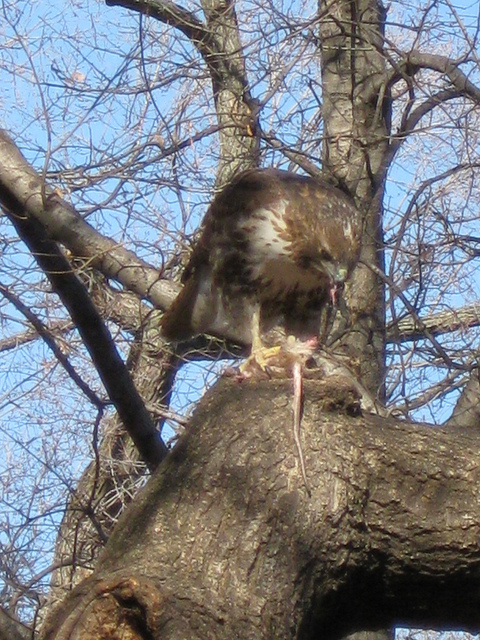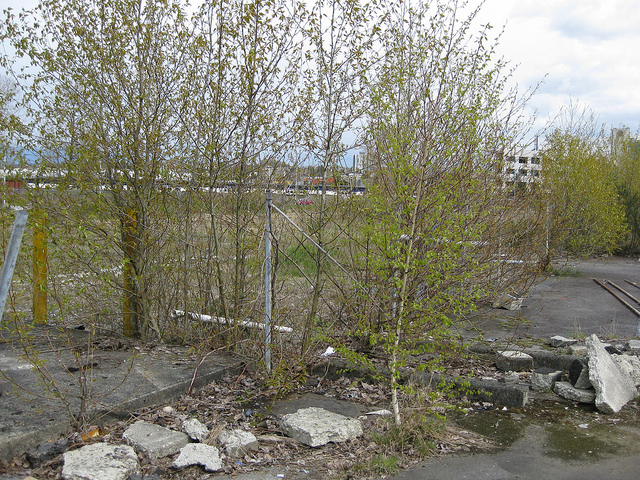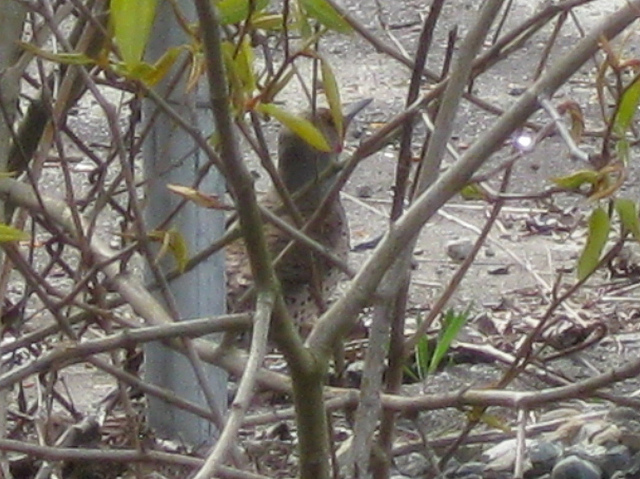The steady incursion of the coyote into North American cities is an outstanding example of the kind of hyper-ecologies I am interested in. Though it is native, the coyote evolved as an interstitial species, having to eke out a living in the ecological between the wolf and the fox, and so it always had to be adaptable. Vacant industrial lands and suburban cul-de-sacs have become as much home to the coyote as the arroyos and sage steppes of its traditional habitats, but they offer rich new food sources in the form of ubiquitous garbage and dim-witted house pets. Quick to learn and selectively omnivorous, the coyote thrives in the wreckage of wilderness, where its larger cousin the wolf has been largely extirpated.
Among the sidewalks and rhododendrons and stupendously overpriced little stucco houses of East Vancouver, I was charmed to come across one of these clever canids, making its rounds; methodically investigating the driveways and gaps between houses for a chance at some badly packed trash or a succulent, over-fed cat. I followed it for, a while and though it seemed well aware of my presence, it maintained just enough distance to continue with its nonchalant foraging, never once breaking its stride. Despite our fantasies of control over our built environments, there is no doubt in my mind who will ultimately inherit them. Whether tearing into our garbage or chewing on our bloated corpses, the coyote will surely outlast us. Whether we like it or not, the future is feral…
|
||||||
|
As post-hockey riot Vancouver sweeps the last shards of glass from its sidewalks and processes a myriad insurance claims, the hand-wringing and finger pointing are proceeding apace in the mad rush to save the reputation of the so-called ‘most livable city on earth.’ But my question is – why were we so surprised? To make sense of the images of water-polo playing sons of surgeons setting fire to police cars and private school toffs rampaging through the ruins of bank lobbies, we might learn more from the words of a dead science fiction writer than from any of the outraged utterances of the mayor and the chief of police. J.G. Ballard would have loved this riot. In fact he consistently imagined situations like this (and worse) in his dystopian novels and short fiction. In his novella Running Wild, the children in a gated community of middle class professionals band together and slaughter their parents within the tasteful grounds and interiors of their designer homes. In High Rise, the residents of a luxury apartment tower wage tribal warfare against rival floors in an effort to alleviate the boredom of their cosseted and privileged lives.
“Unable to express their own emotions or respond to those of people around them, suffocated under a mantle of praise and encouragement, they were trapped forever in a perfect universe. In such a society, madness is the only freedom.” J.G. Ballard: Running Wild (1988.) In many ways Vancouver’s hockey riot was likewise an expression of raging bourgeoise ferality; essentially, a riot about nothing – a ‘Seinfeld’ of riots to which it is a mistake to ascribe any political motive. In the wake of the play-off defeat, with the Canucks scoring ‘zero,’ something had to take the place of that nothing even if that something was pointless violence. At least that could be remembered, tweeted and socially networked. To read any more into this is to be mistaken, yet for me, the underlying message is clear: Beware of the middle class. Especially its young men. For they exist increasingly in a state that could be described as a deficit of the real, which is dangerous and unstable place, full of unfocused outrage and an overdeveloped sense of personal entitlement that constantly simmers just below the surface. The riot wasn’t a conspiracy of any kind but rather the lack of one – a set of preconditions where a massive charge of nothingness had accumulated to which the riot was an almost electrical response; the closing of a circuit to the unmet expectations of an ontologically bereft, predominantly suburban, mob. With the loss of the game, the value of the Canuck brand (temporarily) evaporated for them, triggering a wave of buyer’s remorse through the hyped-up expectations of the crowd. In the brutal logic of the situation, the outpouring of rage had to be taken out on the city itself, the brand’s associative container. In that sense the ubiquitous slogan: ‘We are all Canucks,’ proved truer than it needed to be. The ensuing riot and looting were pure reification, a desperate desire to wrest meaning from the void, to be part of an authentically ‘real’ experience outside the purview of the corporate machine that had so spectacularly failed to deliver. No matter how one feels about it, the hockey riot unarguably ‘happened,’ the physicality of its burned-out automobiles and pillaged storefronts comprising an iconic collective experience that will be remembered for a long time to come, despite the almost immediate attempts by civic boosters to re-narrative-ize it by drawing media attention to isolated acts of heroism and the bonhomie of those engaged in the clean up effort.
The Stars of the Riot: White Riot – I wanna riot White Riot – A riot of my own The Clash – White Riot 1977 But getting back to the situation of those young, suburban men… What would prompt a privileged Maple Ridge kid like 17 year-old Olympic hopeful, Nathan Koytlak to be photographed in front of a cheering crowd, holding a lighter and stuffing a rag into the gas tank of a police cruiser? Not to pick on young Nathan, who like so many others has issued his legally-vetted and suitably contrite public apology. In keeping with his class privilege, Nathan’s ‘brand of one’ might someday be rebuilt, but such scenes were played out countless other times, the perpetrators more or less interchangeable, all of them egged-on by appreciative, live-blogging audiences recording each detail on a panopticon of socially networked devices. In a sense the individual stars of the riot, served as avatars for the feral aspirations of the many, a kind of crowd-sourced, ‘Vancouver’s Got Talent,’ reality TV show, where in order to distinguish themselves, participants vied against each other in contests of escalating ‘bad-assedness.’ There are parallels also with computer gaming, though it would be too simplistic to call it a cause. One wonders if the ubiquitous Grand Theft Auto trope of flames and pixelated blood spatter against the backdrop of a burned out city has so thoroughly colonized the optical subconscious that it now seems natural somehow, even reassuring, a kind of default habitat where young men in particular are used to operating. The post play-off anomie created the perfect psychological environment for the unleashing this pent-up, first-person-shooter energy against the bland, manufactured seamlessness of the theme-parked urban landscape, every broken window and burned-out car as unique as a snowflake and a marker of the perpetrator’s now extended personal space.
Lek Behavior:
And what of the grand old game itself? Much ink has been spilled about the gratuitous violence in professional hockey. But it isn’t hockey per se. As in other sports, there is an obvious mimetic component that compels some spectators to re-enact the gladiatorial dynamic of the game outside the confines of the arena. This isn’t exactly new. Sports riots have been recorded from as far back as Roman times and have more to do with tribal rivalry than anything intrinsic to specific games. Soccer isn’t a particularly violent sport but English football hooligans are some of the most brutal fans on earth. That team sports serve as a kind of proxy combat onto which spectators project their own polemical aspirations is well known, and the environment around high stakes matches can provide ideal conditions for territorial violence by concentrating large numbers of adrenally stimulated and often intoxicated young males into confined spaces. The resultant eruptive behavior closely resembles a form of animal territorial display called ‘lekking,’ prevalent in such species as sage grouse and certain ungulates. It works (to paraphrase Wikipedia) like this: The only surprise to this whole sorry debacle was that police and civic officials were so woefully under-prepared. Though a similar situation had occurred back in 1994, the city was once again caught on the back foot. One can only speculate as to why. Against its spectacular backdrop of snow capped mountains and unspoiled forest verdure, the haze of magical thinking frequently occludes acknowledgement of some of Vancouver’s most pressing problems. This isn’t anyone’s fault in particular, but a kind of climatic reality – an endemic social viscosity and an overarching cultural attachment to the pursuit of personal bliss. The result, unfortunately is that some pretty big issues get swept up under the rug. The riot of 2011 affords this odd, little adolescent city an opportunity to take stock and finally begin to grow up. Let’s hope that happens soon.
Another spring is upon us here on Canada’s West Coast, replete with its promise of respite from the brooding winter sky and the months of cold, slimy rain. The occasional few hours of sunshine, the unfurling of tender buds and in the hollows – the din of tree frogs in their tremulous nuptial chirping; it all reminds me that this is the season of new life and new beginnings. Though Timothy Morton describes the current ecological moment as a kind of planetary ‘charnel ground’, i.e. we have basically already died and just haven’t realized it yet, I am perhaps stubbornly holding out for some hope. Despite the epic damage our species has wrought on its fellow organisms and on the very climatological systems that keep everything in its finely tuned balance, I am seeing signs here and there that the processes of planetary repair are kicking in, and that one day, the worst of what we have done will be obscured beneath layers of unquenchable biomass. Which is not to say I am in denial about the severity of our present situation. Accelerated extinction and human-induced climate change are all too real and many of earth’s more fragile ecosystems have been badly diminished or at reduced to ‘museum’ status, surviving as relics only within the confines of national parks, constantly under threat from illegal logging, poaching and the abrasions of excessive tourism. Though I think it premature to declare the ‘end of nature,’ it is safe to say we are at the end of wilderness. But what does this mean exactly? To be sure the figure/ground relationship between man and nature has changed fundamentally, perhaps irrevocably, as Bill McKibben pointed out in his prescient book, way back in 1989. A single species, ours, is now the greatest driving force behind species biodiversity, climate change and even geomorphology, via the amount of the earth’s crust we move and the structures we build, activities that geologists calculate now use up more energy annually than is expended by the natural growth of mountains and the deposition of sediments. Yet there are also signs that species are responding to us by evolving at an unprecedented rate. The New Scientist describes a type of ‘fast-track’ evolution, in which significant morphological traits of animals can evolve in mere decades to help them adapt to changing environmental conditions, provided there is enough genetic diversity in the original population to allow the expression of ‘back-up’ genes. Several of Darwin’s iconic Galapagos finches are already changing their beak sizes as they literally evolve into new species as the conditions of their Galapagos habitat are altered by changing climate and by the selective pressure of being fed leftover rice by the throngs of eco-tourists who have come to see them. The article also cites the now classic case of ‘industrial melanization’ in peppered moths, which rapidly evolved darker pigmentation in response to the contamination of the English Midlands by coal soot during the Industrial Revolution. Blackness too confers a survival advantage to organisms, especially birds, living in the ‘zone of alienation’ around the Chernobyl reactor site. It turns out that darker pigmentation frees up a molecule called glutathione (GSH), an antioxidant which protects tissues from radiation damage. So darker birds succeed, while their lighter cousins don’t, which has already skewed the way birds in the area look in the past twenty-five years since the explosion. Amazingly, a conspicuously black, radiotrophic fungus now thrives in one of the most radioactive places in the whole disaster area – the inside surfaces of the concrete sarcophagus that was hastily constructed to contain the radiation spewing from the stricken reactor as they continued to melt down. As well as appearance, animal behavior is rapidly changing as the evolutionary pressure to adapt to the ubiquitous humans presence steadily mounts. These ‘cultural’ shifts are cropping up all over the place as in the case I wrote about previously concerning the extirpation and subsequent recolonization of wolves on Cortes Island, BC (where I live part time.) What is amazing about this situation was not that the wolves came back; they weren’t after all extinct on the nearby mainland; but that they adapted their behavior in response to the denser human settlement they encountered on their return. They now unabashedly lope through populated areas even during daylight hours to feast on a bounty of domestic animals, yard-fattened deer and household trash. Though normally a shy, secretive species, wolves on Cortes are now pushing the envelope in their interactions with the people, maintaining very little distance between themselves and us, their primary predator, and acting nonchalant. I’ve encountered them several times now and I have to say it is quite something to be given the once-over by one of these iconic predators, as is saunters nonchalantly down the same dirt road I frequent on my morning jog. The wolves’ adaptive strategy is clearly working on Cortes as the numbers of wolves remain more or less stable, despite occasional shootings by locals and Provincial Conservation officers, who get called in to cull overly habituated ‘problem’ animals. On the whole, the benefits of associating with humans must outweigh the risks them. The population of their main prey items, raccoons and black-tailed deer, explode in the disturbed, edge habitats humans create such as residential gardens and former clear-cuts that come up in lush alder groves after the conifers get logged out. Though not nearly as successful in our presence as their smaller cousin, the coyote, it’s only natural, I suppose, that some wolves; which are after all a highly intelligent species; have learned to live in our midst. Yet it is an open question as to whether this has a genetic basis. They sure are acting differently though. During the past week, I have heard two reliable reports of wolves, individually and in packs, chasing cars along the roads of Cortes. Clearly their behavior hasn’t stopped evolving yet. A similar situation has arisen in upstate New York, where fishers, previously trapped out from much of their North American range due to the demand for their valuable furs, are returning in droves – not to the remote wildernesses we thought they preferred, and where they continue to decline, but to the fragmented suburban forests and the margins of golf courses of cities like Albany. Like the Cortes Island wolves, these over-sized weasels are learning to exploit the rich food resources available in the interstices of human settlement, hunting down house cats and dodging highway traffic, in marked contrast to their secretive wilderness cousins who abandon habitats frequented by people. These are decidedly cultural shifts from a species we thought categorically could not co-exist with us. Something has definitely shifted within this eastern population of fishers. Human induced hyper-evolution seems a likely explanation. Perhaps most lovely of all is the oft-blogged spectacle of the thousands of Vaux’s swifts that have colonized the disused smoke stack of a school in Portland Oregon. Swifts, small, swallow-like birds, traditionally need the large hollow trees, once characteristic of the region’s now largely extirpated old-growth forests, in which to communally nest and roost. Yet the Portland population has somehow transposed this crucial requirement onto what seems a very different set of circumstances. It makes me wonder how many other species are rapidly adapting to our built environment to use as their primary habitat, in the face of the massive evolutionary pressure to do so. Hawks certainly seem to be making this adjustment. During my last few winters in New York City, I was delighted to observe red-tailed hawks roosting in the stately American Elms of Tompkins Square Park, disemboweling the rats they’d snatched right in front of squealing crowds of spectators. These magnificent birds have spawned a new class of paparazzi, who blog their behavior in minute detail and lobby for their protection. A similar situation arose after a group of fellow squatters and I started Cottonwood Gardens in Vancouver. For a short while we were plagued by rats, attracted by the sudden availability of compost piles and the produce we were trying to cultivate. Just as we were about to despair, a pair of red-tailed hawks established a nest on a nearby cottonwood tree and they soon made short work of the rodents. They resided there every nesting season for several years until they were themselves supplanted by a pair of bald eagles who increased the size of the already enormous nest. Twenty years later there are now two bald eagle nests at the Cottonwood Gardens site, in close proximity to each other and one can regularly thrill to the site these apex predators soaring over the factories, warehouses and trash-littered terraine vague of what at first glance seems a most unprepossessing habitat from a wildlife point of view. A recent report in the Guardian described a heavily contaminated refinery site, near Rochester in the UK, as a ‘Lost World,’ of critically endangered insects, which have been all but wiped out in so called ‘natural areas’ elsewhere. There is something about this ruin ecology’s unique interplay of disturbance and neglect that makes it an ideal habitat for these rare creatures. Yet perhaps it is the creatures themselves that have also changed, slowly adapting to live among us in the wastelands and ruins we have worked so hard to create. Our abandoned industrial sites and DMZs have become ‘disaster edens’ – a new frontier in ecological study. My first inkling of this happened during a visit to Berlin in the early 1980’s. I was astonished to observe a thriving diversity of wildlife in the land mine studded strip of no-man’s land between the two sections of the Berlin Wall. Clearly visible were scores of European hares grazing freely on a verdant meadow, too light to trip the lethal devices hidden mere centimeters beneath their twitching noses. They did not however escape the notice of the squadrons of kites, falcons and honey buzzards who regularly patrolled the air above them to pick off any stragglers. Though the Wall has long since been down, Berlin has lately been overrun with native wild boars who swarm in from the countryside to avail themselves of the city’s leafy boulevards, parks and gardens. Their population has grown so precipitously that urban hunters have been contracted to keep the numbers down. In cities we get a preview of the larger trend toward ragamuffin ecologies or what has been called ‘Nature 2.0.’ Here native and exotic organisms co-mingle in hitherto unheard of combinations resulting in meta-ecologies that are adaptive and emergent. These are ecologies of disturbance, often first colonized by fast growing, cosmopolitan so called ‘invasive’ species such as Ailanthus (a.k.a. ‘Ghetto Palm’), Scotch Broom and Buddleja. These are blamed for wreaking all kinds of havoc, though I am increasingly convinced they often stabilize damaged landscapes long enough until native organisms can regain a foothold. I’ve seen this happen in the urban steppes of East Vancouver; abandoned car parks and railway sidings, which are first colonized by the nitrogen fixing Scotch Broom that move in quickly to cover exposed ground until the native Cottonwoods eventually dominate. Though they look different from the cathedral like groves of ancient conifers that are associated with the BC ecological brand, these emergent, pavement loving forests soon attract native birds such as the northern flicker and white-crowned sparrows as well as other creatures such as the coyote, only recently native to British Columbia’s Lower Mainland where it migrated from the province’s interior. Exotic species will forever be part of the mix though, despite the efforts of botanical nativists to ethnically cleanse the landscape of them. 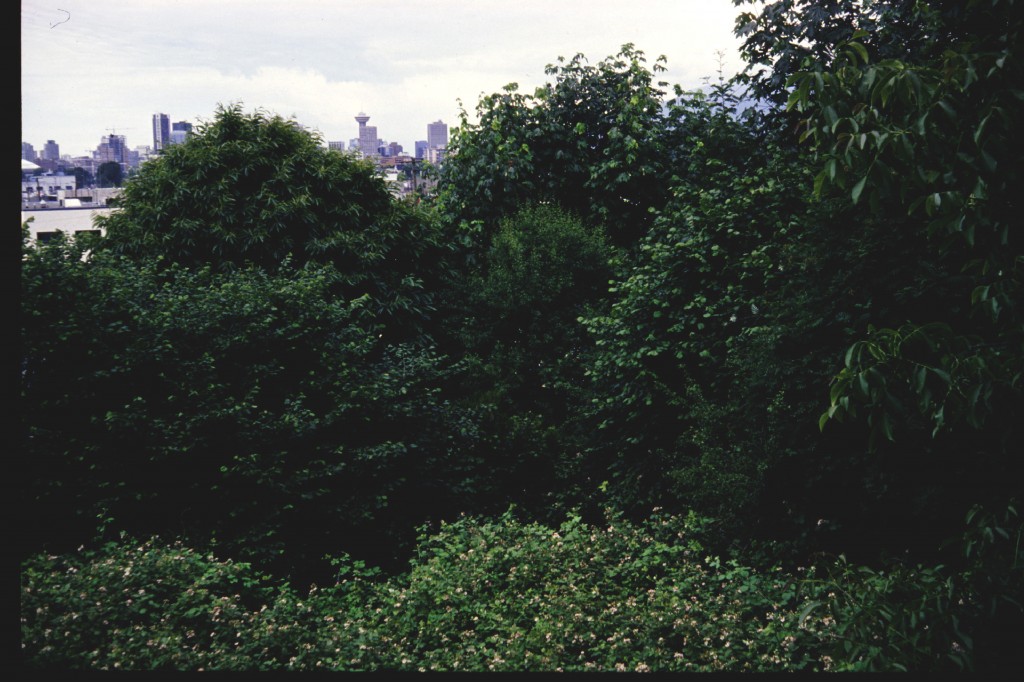 Well developed emergent forest of both native and exotic species (Himalayan Blackberry, English Walnut, Big-leafed Maple, Castanea, Corylus, hops etc.) - East Vancouver (1994) Such processes of colonization and re-adaptation are important to track as they fall outside canonical notions of ecological restoration, which generally presuppose a return to a ‘native,’ prelapsarian kind of species composition, which is becoming increasingly meaningless in the now overarching context of the Anthropocene. I find these new hybrid realities fascinating and hopeful. It means we can do more than just wring our hands at the decline of nature as we thought we knew it. We might as well face it. There is no going back. Now is a good time to intelligently assess our limits and ask ourselves the Zen question: “What can I not do?” Nature might already be several steps ahead of us. BTW: If any of you are in Vancouver from June 20th- 24th of this year, I am teaching a little Continuing Ed Course at Emily Carr University entitled: Open Source City: Field Studies. We’ll travel around town on the Skytrain, examining various emergent landscapes and also examples of temporary autonomous zones – places that people have created as urban commons, which exist outside the mainstream models of planning. I promise it will be a lot of fun, so please sign up if you can!
|
||||||
|
Powered by WordPress · Atahualpa Theme by BytesForAll |
||||||


